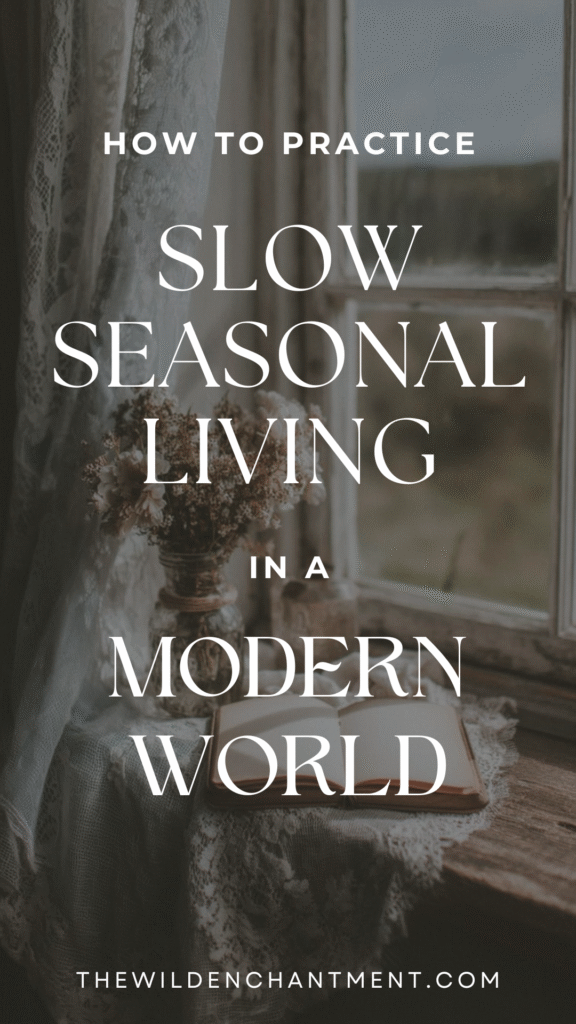This post may contain affiliate links, including those from Amazon Associates. If you make a purchase through these links, I may earn a commission at no additional cost to you. Learn more about our affiliate policy.
The modern world asks us to run at a steady pace no matter what time of year it is.
Our calendars, work schedules, and habits often look the same whether the days are short and cold or long and sunlit.
Yet beneath the surface, our bodies and spirits are quietly responding to nature’s rhythms.
Practicing slow seasonal living means honoring those shifts and letting them guide how we move through our days. This way of living doesn’t require a radical life change.
It’s about tuning into small adjustments that keep you connected to the earth, grounded in your own rhythms, and present in each season.
Why Slow Seasonal Living Matters
Seasonal living is simply the art of syncing your daily rhythms with the cycles of nature.
Just as plants change with the light and animals adapt their energy across the year, we too are designed to ebb and flow. Yet modern routines often push us to resist these natural shifts.
The result is a kind of friction that can leave us feeling disconnected, tired, or restless.
Choosing a slower, seasonal approach is an antidote.
It invites you to see each season as a teacher with its own energy, encouraging you to work, rest, and play in harmony with what’s unfolding outside your window.
It also grounds you in a culture of rhythm rather than rigid routine, allowing space for flexibility, creativity, and gentleness.

Guiding Principles for Seasonal Rhythms
Before layering seasonal practices into your days, it helps to anchor into a few simple mindsets.
- Rhythm over routine: Routines can feel strict, but rhythms allow flow. Think of them as patterns you follow loosely, with room to adapt.
- Intention over busyness: Instead of filling your schedule, focus on what feels meaningful. Let each season offer cues for what deserves your energy.
- Small shifts, slow changes: You don’t need to change everything at once. Adjusting one area of your life—food, light, or rest—is enough to begin.
- Observe, listen, respond: Notice how the natural world is changing. Is the light softer, the air cooler, the mornings longer? Let those observations inspire small shifts in your habits.
These principles keep the practice of seasonal living from becoming overwhelming or perfectionist. They are gentle reminders that you’re participating in something alive and flexible.
If you’re curious about weaving these ideas into your day-to-day, you might enjoy exploring 12 easy seasonal self-care rituals for wild women that bring rhythm and intention to each turn of the year.
Morning and Lighting Rituals

How you begin your day shapes the rhythm that follows. Seasonal living invites you to start with light.
In spring and summer, this might mean opening your curtains to let the early sun flood your space, or stepping outside barefoot for a few breaths of fresh air.
In autumn and winter, it may look like lighting a candle to honor the slower arrival of the day.
A short stretch, a cup of herbal tea, or a few lines in a journal can anchor the morning in calm awareness of the season’s energy.
For more ideas for aligning your mornings with nature, see how to create a morning routine that connects you to nature’s rhythm.
Work, Focus, and Productivity
Even in modern jobs that demand consistent hours, you can adjust your approach to work with seasonal cues.
In spring, when energy rises, mornings may feel more productive. In summer, you might notice focus peaks earlier in the day, freeing afternoons for rest or creative play.
Autumn often supports deep, reflective work. Winter may ask for steady, measured effort balanced by longer rest.
Consider adding small seasonal breaks to your workday. A quick walk outside, pausing to feel the sun, or sipping a seasonal tea can reset your focus and reconnect you with nature.
Food and Kitchen Practices

One of the easiest ways to live seasonally is through food.
Shopping at farmers’ markets or paying attention to what’s in season helps you naturally vary your meals. In spring, focus on tender greens and lighter dishes.
In summer, savor ripe berries, stone fruits, and vibrant salads.
Autumn invites root vegetables, apples, and warming spices.
Winter calls for hearty soups and slow-cooked stews that comfort and sustain. These meals not only nourish but also connect you to the earth’s cycle of abundance and rest.
Eating itself can be a seasonal ritual. Slow down, cook more often when days grow shorter, and invite friends to gather at your table when light lingers in the evenings.
Rest, Sleep, and Evening Rhythms
As days shorten and lengthen, adjusting your evening habits can make rest feel more natural. In summer, allow evenings to stretch later with time outdoors, stargazing or sharing food with friends.
In winter, lean into earlier bedtimes and cozy wind-down rituals.
Create a seasonal bedtime routine: herbal tea in autumn, candlelight journaling in winter, a cool shower in summer, or a fresh-air meditation in spring. Honoring these shifts signals to your body that it’s safe to rest deeply.
Home and Environment

Your home can mirror the turning of the seasons in subtle, soulful ways. In spring, clear clutter and bring in fresh flowers.
In summer, keep spaces light and airy, with bowls of fruit and open windows. Autumn is a time for layering textures—blankets, candles, dried flowers. Winter calls for warmth: soft lighting, evergreens, wool throws.
These small touches keep your environment aligned with the rhythms outside, creating a sanctuary that feels alive and responsive.
Seasonal Rituals and Anchors
Beyond the daily, you can create seasonal anchors: rituals that mark the passage of time.
In spring, plant seeds or start a fresh creative project.
In summer, make a list of outdoor adventures to savor.
Autumn is perfect for gratitude journaling or harvesting herbs. Winter invites reflection, reading, and rest.
These anchors remind you that the year is a circle, not a straight line, and each part of it offers something valuable.
Creating a simple altar that shifts with the seasons can also become a grounding practice, here are some beautiful seasonal altar ideas to inspire your own ritual space.
Seasonal Examples in Practice
To picture how this works, imagine a year lived in rhythm.
- Spring: You rise earlier with the sun, eat lighter meals, and take brisk walks to awaken your energy. Your home feels airy, with fresh flowers and open windows.
- Summer: Work shifts earlier in the day, leaving afternoons free for rest or time outside. Meals are simple and colorful, evenings stretch into shared meals or starlit moments.
- Autumn: You slow your pace, reflect on what you’ve grown, and spend more evenings indoors. Warm drinks and layered textures bring comfort.
- Winter: You honor the darker mornings with candles, keep meals hearty, and give yourself permission for longer rest. Journaling or quiet creative projects help you stay rooted.
These shifts don’t have to be rigid or elaborate. They are simply gentle adjustments that keep your life aligned with nature’s cycle.
A 30-Day Seasonal Starter Plan
To begin, choose one area of focus for the next month. It could be food, light, or rest.
For the first week, simply observe—notice the season’s cues around you. In the second week, add one small practice, such as seasonal cooking or a morning walk.
In the third week, add another, perhaps adjusting your evening routine. In the fourth week, reflect on how these shifts feel. From here, continue layering small practices, letting each season teach you its own rhythm.
Closing Inspiration
Seasonal living is a way of remembering that you are part of the natural world, not separate from it. By slowing down and aligning with the seasons, you create space for deeper presence, joy, and connection. This isn’t about adding more to your life, but about noticing what already surrounds you. As you begin, let one small shift carry you forward.
Light a candle, open a window, cook a meal with seasonal produce. Each act is a step back into rhythm, a reminder that life is meant to be lived in cycles of rest and renewal. In this way, your modern daily rhythms can feel enchanted yet grounded, flowing in harmony with the turning year.



